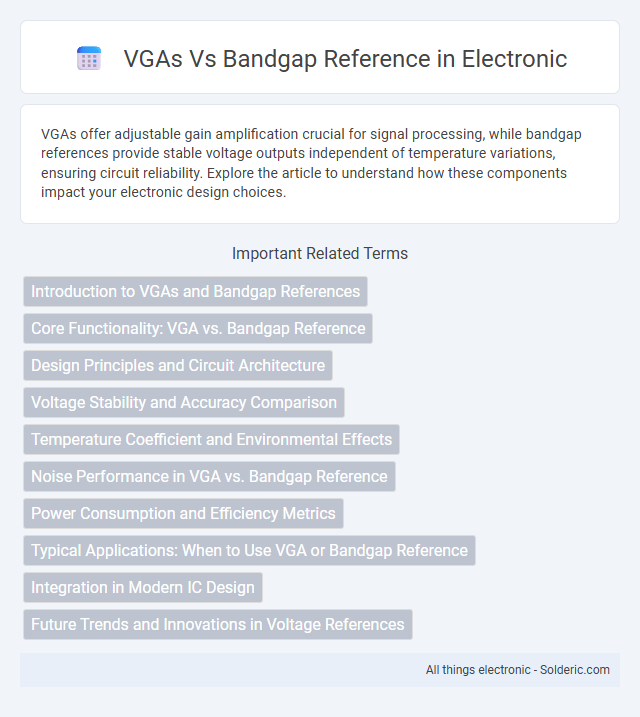VGAs offer adjustable gain amplification crucial for signal processing, while bandgap references provide stable voltage outputs independent of temperature variations, ensuring circuit reliability. Explore the article to understand how these components impact your electronic design choices.
Comparison Table
| Feature | Variable Gain Amplifiers (VGAs) | Bandgap Reference |
|---|---|---|
| Primary Function | Adjusts signal gain dynamically | Provides stable reference voltage |
| Application | Signal conditioning, communication systems | Voltage regulation, analog circuits |
| Operation Principle | Controlled gain based on input or control voltage | Combines voltage drops of bipolar transistors |
| Output | Variable amplitude signal | Constant, temperature-independent voltage (~1.25 V) |
| Temperature Stability | Depends on design; moderate | High stability over temperature range |
| Typical Use | Audio, RF, instrumentation | Voltage reference in ADCs, DACs, power supplies |
| Complexity | Medium to high, with variable control circuits | Low to medium, relies on transistor matching |
Introduction to VGAs and Bandgap References
Variable Gain Amplifiers (VGAs) dynamically control signal amplitude, essential for audio processing, communication systems, and sensor interfaces. Bandgap References provide stable voltage outputs independent of temperature and supply variations, crucial for precise analog circuit performance. Your system's accuracy and reliability often depend on integrating both VGAs for signal adjustment and Bandgap References for consistent voltage standards.
Core Functionality: VGA vs. Bandgap Reference
A Variable Gain Amplifier (VGA) adjusts signal amplitude dynamically to maintain consistent output levels despite varying input strengths, making it essential in communication and audio systems. In contrast, a Bandgap Reference provides a stable voltage reference independent of temperature and supply variations, crucial for accurate analog-to-digital conversions and precise circuit operation. Your choice between VGA and Bandgap Reference depends on whether you need adaptive signal control or a constant, reliable voltage baseline in your electronic design.
Design Principles and Circuit Architecture
Voltage Gain Amplifiers (VGAs) utilize variable gain control mechanisms, often implemented through transconductance variation or digitally controlled resistive elements, enabling precise signal amplification within adaptive systems. Bandgap Reference circuits rely on the predictable temperature coefficients of semiconductor junctions, combining complementary voltage components to generate a stable, temperature-independent reference voltage typically around 1.2V. The architecture of VGAs integrates feedback loops and variable transistors for dynamic gain adjustment, whereas Bandgap References employ bipolar junction transistors and resistive networks arranged to cancel temperature effects, ensuring consistent voltage outputs across varying environmental conditions.
Voltage Stability and Accuracy Comparison
Voltage Gain Amplifiers (VGAs) offer adjustable gain with moderate voltage stability but tend to exhibit higher noise and drift compared to Bandgap References, which provide precise and highly stable voltage outputs regardless of temperature variations. Bandgap References utilize a temperature-compensated voltage generation method, ensuring superior accuracy and long-term stability essential for precision analog circuits. VGAs are preferred in applications requiring signal amplitude control, while Bandgap References excel in providing reliable voltage benchmarks for ADCs and DACs.
Temperature Coefficient and Environmental Effects
VGAs exhibit varying temperature coefficients that can lead to gain drift, impacting signal fidelity under fluctuating environmental conditions. Bandgap reference circuits provide highly stable voltage outputs with minimal temperature coefficients, typically in the range of a few ppm/degC, ensuring consistent performance across temperature variations. Environmental effects such as humidity and supply voltage changes minimally influence bandgap references compared to VGAs, which are more prone to parameter shifts caused by external factors.
Noise Performance in VGA vs. Bandgap Reference
Noise performance in VGAs (Variable Gain Amplifiers) is critical as they directly affect signal integrity by amplifying noise along with the input signal, often resulting in higher output noise levels compared to bandgap references. Bandgap references provide a stable, low-noise voltage output essential for precise analog circuit performance, exhibiting superior noise characteristics due to their carefully designed temperature-compensated semiconductor junctions. Your choice between VGA and bandgap reference depends on whether low noise or adjustable signal gain is prioritized in the application.
Power Consumption and Efficiency Metrics
Voltage Gain Amplifiers (VGAs) typically exhibit higher power consumption compared to Bandgap References due to their dynamic gain control circuitry, which demands continuous current flow. Bandgap References are inherently more power-efficient, often designed to operate with ultra-low quiescent current, making them ideal for low-power applications. Efficiency metrics highlight that Bandgap References maintain stable voltage outputs with minimal power draw, while VGAs prioritize signal amplitude modulation at the cost of increased energy usage.
Typical Applications: When to Use VGA or Bandgap Reference
VGAs (Variable Gain Amplifiers) are typically used in applications requiring dynamic signal amplitude control, such as audio processing, wireless communications, and automatic gain control systems. Bandgap references provide a stable voltage output independent of temperature and supply variations, making them essential for precision analog circuits, voltage regulators, and ADC/DAC calibration. You should choose VGAs when adjusting signal levels dynamically and bandgap references when a consistent, temperature-insensitive voltage is crucial.
Integration in Modern IC Design
VGAs (Variable Gain Amplifiers) and Bandgap References serve critical roles in modern IC design, with VGAs providing adjustable signal amplification and Bandgap References ensuring stable voltage despite temperature variations. Integration of VGAs enables dynamic signal conditioning within complex analog front-ends, while Bandgap References are essential for accurate biasing and voltage regulation across various process technologies. Your IC designs benefit from the seamless incorporation of both components to achieve high performance and reliability in mixed-signal environments.
Future Trends and Innovations in Voltage References
Future trends in voltage references emphasize enhanced precision, stability, and power efficiency, with innovations steering beyond traditional VGAs and bandgap references. Emerging technologies like CMOS-compatible silicon carbide and graphene-based references promise improved temperature resilience and miniaturized designs. Your applications stand to benefit from integrated smart voltage references incorporating AI-driven calibration for real-time adaptation across varied operating conditions.
VGAs vs Bandgap Reference Infographic

 solderic.com
solderic.com